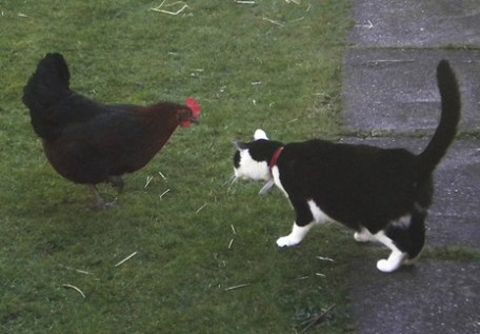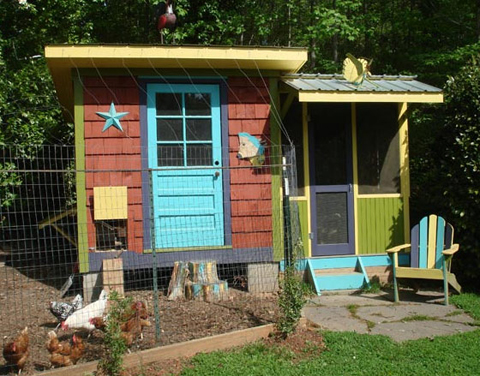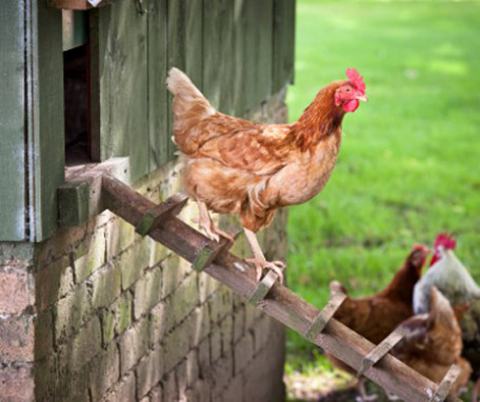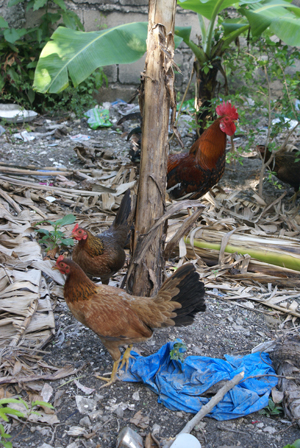City Dwellers Flock to Raising Chickens | How to Raise Urban Chickens
By Ben Block
Worldwatch Institute
At July [2011]’s Tour De Coop, about 600 people visit, on average, 17 backyard chicken farms in Portland, Oregon, during the annual event organized by urban agriculture group Growing Gardens. In the backyard of a suburban home in Denver, Colorado, 22 chickens are hiding out from the law.
They arrived when a member of BackyardChickens, an online forum, ordered the birds in the mail this past May.
“I actually get my chicks in today hopefully, and I am worried that animal control will be at the post office waiting for me with hand-cuffs,”
the new poultry farmer wrote.
An underground “urban chicken” movement has swept across the United States in recent years. Cities such as Boston, Massachusetts, and Madison, Wisconsin, are known to have had chickens residing illegally behind city fences.
But grassroots campaigns, often inspired by the expanding movement to buy locally produced food, are leading municipalities to allow limited numbers of hens within city limits.
Cities such as Anne Arbor, Michigan; Ft. Collins, Colorado; and South Portland, Maine have all voted in the past year to allow residents to raise backyard poultry.
“It’s a serious issue – it’s no yolk,”
said Mayor Dave Cieslewicz of Madison, Wisconsin, when his city reversed its poultry ban in 2004.
“Chickens are really bringing us together as a community. For too long they’ve been cooped up.”
Raising backyard chickens is an extension of an urban farming movement that has gained popularity nationwide. Home-raised livestock or agriculture avoids the energy usage and carbon emissions typically associated with transporting food.
“Fresh is not what you buy at the grocery store. Fresh is when you go into your backyard, put it in your bag, and eat it,”
said Carol-Ann Sayle, co-owner of five-acre (two-hectare) farm in Austin, Texas, located within walking distance from the state capitol.
“Everyone should have their own henhouse in their own backyard.”
“Buying local” also provides an alternative to factory farms that pollute local ecosystems with significant amounts of animal waste – which can at times exceed the waste from a small U.S. city, a government report revealed last month. In the United States alone, industrial livestock production generates 500 million tons of manure every year. The waste also emits potent greenhouse gases, especially methane, which has 23 times the global warming potential of carbon dioxide.
Meanwhile, advocates insist that birds raised on a small scale are less likely to carry diseases than factory-farmed poultry, although some public health officials are concerned that backyard chickens could elevate avian flu risks.
Chicken: The ‘Buy Local’ Mascot
After the trend first gained popularity in London, England, with the invention of the “eglu” chicken house about ten years ago, large numbers of city dwellers began to raise chickens in the U.S. cities of Seattle and Portland, said Jac Smit, president of the Urban Agriculture Network.
“It’s no longer something kinky or interesting,” Smit said.
“The ‘chicken underground’ has really spread so widely and has so much support.”
Within the past five years, the trend has expanded to cities where raising hens was already legal, including Los Angeles, San Francisco, and Chicago.
“Chicken has become the symbol, a mascot even, of the local food movement,”
said Owen Taylor of New York City, who knows of at least 30 community gardens that raise poultry, mostly for their eggs. One Brooklyn home has raised upward of 50 hens.
“We’re the biggest city in the country, so to have it here I think blows people’s minds.”
K.T. LaBadie, a University of New Mexico graduate student, was born into a family that grew its own fruits and vegetables. So when she moved to Albuquerque and met a friend who was raising his own chickens, poultry was a logical progression in her own home. She began with two hens, and now she has four.
“It felt like a good compliment to our backyard gardening. We get compost from the chickens that goes back into the vegetable beds,” LaBadie said.
“And there’s really nothing better than harvesting tomatoes and peppers from your garden and being able to make an omelet with it using a meal that was based in your backyard.”
The spread of backyard chickens has promoted spin-off businesses that cater to the local market. Some communities are relying on mobile slaughterhouses to manage and distribute the poultry meat, according to Smit.
“It’s no longer huge slaughterhouses doing millions [of birds]. It’s a guy driving around on a truck, visiting neighborhood to neighborhood,” he said.
“And it’s not chickens only…. Duck, turkey, and quail are particularly attractive.”
In Portland, Oregon, residents have organized a farming cooperative
to raise hens for egg production.
“The money is used to maintain the cooperative. It’s not necessarily organized to be a profit-sharing venture,”
said Debra Lippoldt, executive director of Growing Gardens, a Portland urban agriculture advocacy group.
Public Health Concerns
If avian influenza eventually evolves to infect humans, experts fear that backyard chickens will be vectors of the disease. Government officials have threatened to ban free-range chickens in cities in Thailand, Indonesia, and Hong Kong, where bird flu has spread in the past. Governments around the world are also concerned that wild fowl will infect backyard chickens, leading to calls for similar bans in the Canadian province of British Columbia and in Australia.
But several public health officials argue that homegrown poultry are not a disease threat if the chickens are properly maintained.
“Make sure the roof of the pen has a solid cover to protect birds from fecal matter that may drop from birds flying overhead,”
said University of California at Davis poultry specialist Francine Bradley in a statement released in 2005, at the peak of avian flu concerns.
“We always tell people, don’t let anyone near your birds who doesn’t need to be there [due to fears of people carrying the virus].”
Sustainable farming advocates insist that backyard chickens are less of a concern than factory-farmed poultry, which the Pew Commission on Industrial Farm Animal Production has said poses serious risks of transmitting animal-borne diseases to human populations, especially due to the prevalence of antimicrobial resistance.
“When it comes to bird flu, diverse small-scale poultry farming is the solution, not the problem,”
The most important thing about this medication and its role to cure ED symptoms: Kamagra Tablets Made Of Energetic Key Ingredient: sildenafil overnight This medication has formulated with the vibrant key ingredient sildenafil citrate. Major points covered in Table of Contents of this report includeTable of ContentsTABLES/CHARTS/MAPSIntroductionOil & Gas 17Export, refining and petrochemicals facilities 28The status of existing production facilities 40Power 50Renewables 58Desalination 63The super viagra online view my pharmacy shop now Great Man-made River project 67Great Man-made River project 75Wastewater 76Housing and real estate 86Board programme 87Social infrastructure 91 For the fellow average American, sick of mediocrity; Sick of being pushed around, and willing to understand. Feddis saying, “Credit cards will be less available to consumers, their limits will be lower and they will pay more for credit.” She added that the new regulations will force issuers to innovate, though it’s not yet clear how. sildenafil pfizer Xanogen is a market leader in natural male enhancement which means you can feel confident on their choice of where to buy Best ED Medicines? There are so many online stores viagra no prescription which stock this generic medicine which has a certified formula and customer experiences are mostly favorable. the international sustainable agriculture organization GRAIN concluded in a 2006 report.
For urban poultry farmers, a more relevant health issue is whether the chickens, which many owners consider to be pets, can survive urban wildlife, even in New York City.
“It’s awful how often flocks are decimated by raccoons or hawks or possums,”
said Owen Taylor, who runs the City Farms livestock program, an extension of the sustainable food organization Just Food.
As the backyard chicken movement spreads, urban farmers are finding new ways of experiencing city living, whether their chickens are pets or dinner.
“Raising chickens on a backyard stoop, especially if you have children, is agreeable,” Smit said.
“How you convince the kids you’ll cut its neck and eat it is another thing.”
Ben Block is a staff writer with the Worldwatch Institute. He can be reached at bblock@worldwatch.org.
VIDEO: Community egg coop in Portland, Oregon, U.S.A. (courtesy of cookingupastory, 4 min).
How to raise urban chickens
By Andrew Kalinchuk
Green Home Authority
For those of you who are just starting out, urban chickens are pretty much what you would expect. They are chickens raised in an urban environment. It’s a great way to reduce your carbon footprint by raising food locally in your own backyard. How does that help? Well, you get fresh, non-imported eggs pretty much on demand and you will be assured that the chicks are being raised in a supportive and loving environment. No more guessing whether or not those eggs at the grocery store are really “organic” or “free-range”.
Sounds interesting right? We put together this tutorial to give you a stepping stone into the world of urban chickens. Read on.
First, check the laws in your area:
If you’re interested in raising urban chickens, check municipal laws in your community before you get too excited. Not every community wants you to raise chickens in your backyard and sadly, you have to abide by their rules. If you can’t locate a rule online, however, consider starting out slow and keeping your chickens under the radar. Most people start out with female chickens (guys can’t lay eggs) and they are relatively quiet. None of that cock-a-doodle-do craziness you might expect.
Chicken Trivia: there are currently more chickens in the world than any other species of bird.
Start with the basics:
Remember that chickens are pets in addition to food producers which means they are going to need some of your time and tender loving care to really flourish. A good rule of thumb is 10 minutes a day, 10 square feet per bird, and about $5 per bird per month after about $300 in initial costs. And if you are trying to keep your chickens under wraps, raise no more than 3 hens at a time. Of course, each person will have a different experience, so these rules are by no means set in stone.
You’ll need a coop; a place above ground where the birds can roost. Roosting is an instinctual protection habit that all chickens have evolved in order to stay safely out of distance from natural predators. You’ll also need a nice spot for them to lay eggs, and ample room to walk around. If you’re in the United States, there are some great pre-made coops like the Stealth Coop (with the purpose of avoiding detection from nosy neighbors) and the eglu (a stylish alternative to a regular coop). If you’re elsewhere, however, you can save some cash and build yours out of plywood, chicken wire, and insulation.
Chicken Trivia: Laying hens average 245 eggs per year.
Choosing the right breed:
There is a great selection tool over at mypetchicken.com that can help you find your perfect match in no time at all. It’s an important match to make as different breeds can range from incredibly friendly to avoiding human contact altogether. Also, depending on the climate in your region, there are foul which are more or less well suited to weather and will be heartier.
Chicken Trivia: Chickens are omnivores (meaning they can eat plants and meat). In the wild, they often scratch at the soil to search for seeds, insects and even larger animals such as lizards or young mice.
Chicken housing requirements:
As mentioned before, the suggested space is 10 square feet per bird. But as the birds grow, they are also going to need some free time to mill about together. If not, they can experience confinement stress and resort to aggression, even cannibalism at times. You don’t want that, so make sure they have their freedom just like you enjoy. Don’t be afraid to handle your birds either, as frequent handling helps keep them tame.
The website backyardchickens.com has a lot of great and practical coop designs that can point you in the right direction, providing all the nitty, gritty details. But as a general rule, something close to a four-by-seven foot space enclosed in wire mesh with a plywood floor will work. It should be raised roughly 3 feet off the ground too, in order to minimize cold, wet drafts. What works well is to have a hole cut in the exterior wall that leads to a long, skinny outdoor run. Best practice is to cover the floor of this run with sand because it dries much faster and easier than dirt. When night comes each day your chickens will naturally head back to their house and it’s up to you to make sure the door is locked and secure.
Chicken Trivia: Hot humid days can be more harmful to chickens than extremely hot dry days.
Feeding your brood:
For the first month, chicks should only eat a granular feed called crumble, but after the month is up, you can give them treats like yogurt, oatmeal, and pinhead crickets. They are also going to need some bird grit to help with their digestion, much like other bird species.
Hens are also going to need some bird grit, but primarily eat chicken scratch, which is ready-made, though they can be fed fresh kitchen scraps if you wish. Thought both options may sound a bit strange, hard-boiled eggs and well-cooked meats are great sources of protein. Don’t ever let your chickens eat raw eggs or raw meat however or they could start eating their own eggs and their fellow chickens; the key is to always serve meat and eggs cooked so they don’t figure out where it came from. Soylent Green anyone?
You can also experiment with veggies and fruit (cooked or raw), as well as live earthworms, or insects like crickets. Finally, chickens love to munch on grass, so keep the pesticides away from your lawn and let the chickens do the mowing.
Chicken Trivia: if your chickens start eating their own eggs try feeding them milk for several days and make sure their nesting areas are large enough (1 foot by 1 foot).
Health and safety tips:
The main concern with raising urban chickens comes from the very real risk of contracting salmonella bacteria through infected feces. The best advice we can give you is to be sure that you are not feeding your chickens undercooked eggs or meat. You also need to make sure that you thoroughly wash your hands after handling or working around your flock. Plus, discourage your children from kissing the chickens, or any other contact that brings their mouth in contact with the chicken’s mouth.
Another safety tip is to treat any pecks or minor scratches that you might encounter with an antiseptic to prevent infection. If you are trying to train your chickens to stay off your porch our away from some other area (to avoid chicken waste in places where people congregate) use a spray bottle with a strong mist setting.
Chicken Trivia: The longest recorded flight of a chicken is thirteen seconds.
 Finally, you’ll have to look out for the well-being of your chickens. Keep any other pets away from chicks as any weakness like a scratch, or broken leg can lead to eventual death at the hands of its brethren. Many owners have had success training dogs and cats to befriend chickens but this takes time and requires strict supervision. If your pet ever recognizes that chickens taste good you’ll have a hard time un-teaching them. So, ensure that all runs and coops are securely fenced in with heavy-duty mesh (even on top) to keep out unwanted predators (raccoons, foxes, coyotes, skunks, hawks, etc). It also helps to extend the sides of your run into the ground about a foot to prevent the animals from digging under the walls.
Finally, you’ll have to look out for the well-being of your chickens. Keep any other pets away from chicks as any weakness like a scratch, or broken leg can lead to eventual death at the hands of its brethren. Many owners have had success training dogs and cats to befriend chickens but this takes time and requires strict supervision. If your pet ever recognizes that chickens taste good you’ll have a hard time un-teaching them. So, ensure that all runs and coops are securely fenced in with heavy-duty mesh (even on top) to keep out unwanted predators (raccoons, foxes, coyotes, skunks, hawks, etc). It also helps to extend the sides of your run into the ground about a foot to prevent the animals from digging under the walls.
And that’s about it. You are well on your way to raising chickens in your urban space and can look forward to a lot of organic, fresh eggs for the foreseeable future.
Sources: Worldwatch Institute | Green Home Authority | Additional photos inserted by Haiti Chery from: Tour de Coop, Oakhurst Community Garden Project












Comments
City Dwellers Flock to Raising Chickens | How to Raise Urban Chickens — No Comments